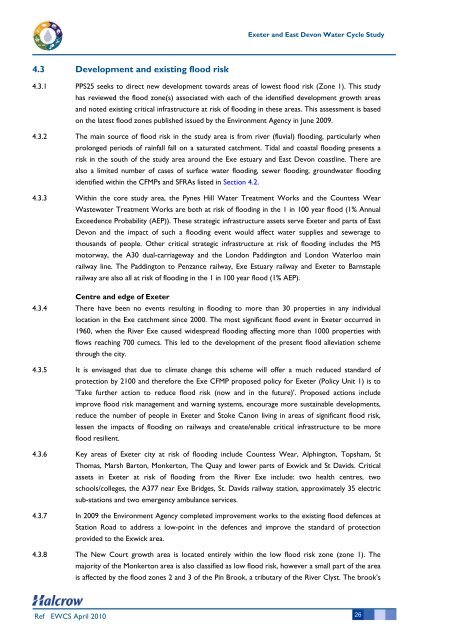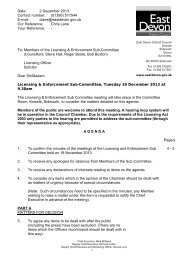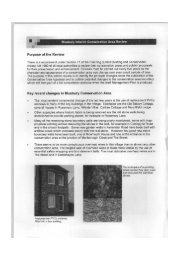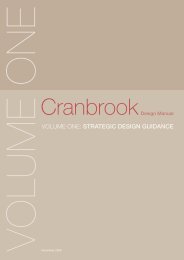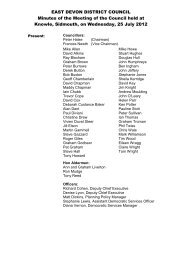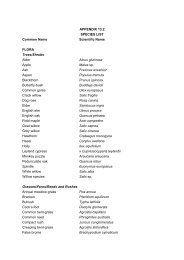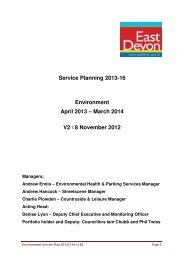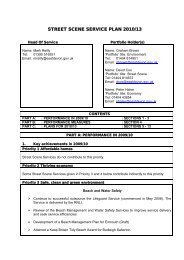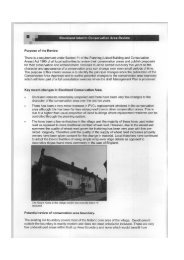Water Cycle Study - East Devon District Council
Water Cycle Study - East Devon District Council
Water Cycle Study - East Devon District Council
Create successful ePaper yourself
Turn your PDF publications into a flip-book with our unique Google optimized e-Paper software.
4.3 Development and existing flood risk<br />
Ref EWCS April 2010<br />
Exeter and <strong>East</strong> <strong>Devon</strong> <strong>Water</strong> <strong>Cycle</strong> <strong>Study</strong><br />
4.3.1 PPS25 seeks to direct new development towards areas of lowest flood risk (Zone 1). This study<br />
has reviewed the flood zone(s) associated with each of the identified development growth areas<br />
and noted existing critical infrastructure at risk of flooding in these areas. This assessment is based<br />
on the latest flood zones published issued by the Environment Agency in June 2009.<br />
4.3.2 The main source of flood risk in the study area is from river (fluvial) flooding, particularly when<br />
prolonged periods of rainfall fall on a saturated catchment. Tidal and coastal flooding presents a<br />
risk in the south of the study area around the Exe estuary and <strong>East</strong> <strong>Devon</strong> coastline. There are<br />
also a limited number of cases of surface water flooding, sewer flooding, groundwater flooding<br />
identified within the CFMPs and SFRAs listed in Section 4.2.<br />
4.3.3 Within the core study area, the Pynes Hill <strong>Water</strong> Treatment Works and the Countess Wear<br />
Wastewater Treatment Works are both at risk of flooding in the 1 in 100 year flood (1% Annual<br />
Exceedence Probability (AEP)). These strategic infrastructure assets serve Exeter and parts of <strong>East</strong><br />
<strong>Devon</strong> and the impact of such a flooding event would affect water supplies and sewerage to<br />
thousands of people. Other critical strategic infrastructure at risk of flooding includes the M5<br />
motorway, the A30 dual-carriageway and the London Paddington and London <strong>Water</strong>loo main<br />
railway line. The Paddington to Penzance railway, Exe Estuary railway and Exeter to Barnstaple<br />
railway are also all at risk of flooding in the 1 in 100 year flood (1% AEP).<br />
Centre and edge of Exeter<br />
4.3.4 There have been no events resulting in flooding to more than 30 properties in any individual<br />
location in the Exe catchment since 2000. The most significant flood event in Exeter occurred in<br />
1960, when the River Exe caused widespread flooding affecting more than 1000 properties with<br />
flows reaching 700 cumecs. This led to the development of the present flood alleviation scheme<br />
through the city.<br />
4.3.5 It is envisaged that due to climate change this scheme will offer a much reduced standard of<br />
protection by 2100 and therefore the Exe CFMP proposed policy for Exeter (Policy Unit 1) is to<br />
'Take further action to reduce flood risk (now and in the future)'. Proposed actions include<br />
improve flood risk management and warning systems, encourage more sustainable developments,<br />
reduce the number of people in Exeter and Stoke Canon living in areas of significant flood risk,<br />
lessen the impacts of flooding on railways and create/enable critical infrastructure to be more<br />
flood resilient.<br />
4.3.6 Key areas of Exeter city at risk of flooding include Countess Wear, Alphington, Topsham, St<br />
Thomas, Marsh Barton, Monkerton, The Quay and lower parts of Exwick and St Davids. Critical<br />
assets in Exeter at risk of flooding from the River Exe include: two health centres, two<br />
schools/colleges, the A377 near Exe Bridges, St. Davids railway station, approximately 35 electric<br />
sub-stations and two emergency ambulance services.<br />
4.3.7 In 2009 the Environment Agency completed improvement works to the existing flood defences at<br />
Station Road to address a low-point in the defences and improve the standard of protection<br />
provided to the Exwick area.<br />
4.3.8 The New Court growth area is located entirely within the low flood risk zone (zone 1). The<br />
majority of the Monkerton area is also classified as low flood risk, however a small part of the area<br />
is affected by the flood zones 2 and 3 of the Pin Brook, a tributary of the River Clyst. The brook’s<br />
26


